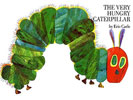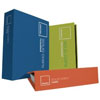What essential books should a design professional own? What a question! Compiling any kind of list is bound to leave out many classics, hidden gems and obvious choices. Many books cross my desk as the editor of The Designer's Review of Books, but the selection below is perhaps a sign of the times—a heavy skew towards the environment, ethics and sustainability, a dash of the left-field and a few classics that no list would be complete without. At least half of these are a decade or two old, which makes one wonder where all the good design writers have gone. Why 19? Why not? Slot number 20 is for your own selection.
1. Design for the Real World by Victor Papanek
Written between 1963 and 1970, many in the design establishment ridiculed Panpanek's thesis on "human ecology and social change." Sadly he died in 1998 and didn't get the chance to have the last laugh—Design for the Real World is even more relevant today than ever. Essential reading for any designer.
2. Grid Systems in Graphic Design by Josef Muller-Brockmann
Muller-Brockmann didn't invent the grid system for typography and layout, but his classic book on the subject brought them to the mainstream of graphic design and, naturally, put them all in order. If you want to be really hardcore, read the German version, Raster Systeme Fur Die Visuele Gestaltung, whilst listening to Kraftwerk.
3. Elements of Typographic Style by Robert Bringhurst
This should be sitting right next to Muller-Brockmann's Grid Systems. This is the bible for many typographers, but anyone involved in doing anything with text layout (hear that, web designers?) should be combing its pages.
4. Designing for People by Henry Dreyfuss
Dreyfuss is widely regarded as the godfather of Industrial Design. Despite the sometimes dated views on gender and class, Dreyfuss' memoirs of his long career in design are a thorough exploration of the designer's place in the world.
5. The Art of Looking Sideways by Alan Fletcher
Described as a "guide to visual awareness," The Art of Looking Sideways is a constant source of inspiring anecdotes, snippets, thoughts and, well, stuff. Imagine someone cut all the best bits out of all your other design and art books and bound them together into one handy, random volume. I've been trying to steal my friend's copy for years.
6. The Design of Everyday Things by Don Norman
Norman's classic on human-object and human-interface interaction feels a little dated from time to time. Partly this is because so many of his ideas have been absorbed into contemporary design thinking across many disciplines. However, it remains the most enlightened of his books and he remains The Don.
7. A Designer's Art by Paul Rand
Most designers I ask cite Rand's A Designer's Art as a must-have, quickly following up with, "in fact, any book by Paul Rand". Never short on opinion, always long on talent, Rand makes for essential reading and A Designer's Art gets a special mention from me because of the chapter on Design and the Play Instinct.
8. The Very Hungry Caterpillar by Eric Carle
"In the light of the moon a little egg lay on a leaf..." If Carle's 1969 masterpiece of illustration, graphic design and old-fashioned paper interaction design doesn't rock your world then you have no heart. For many of us it was our first exposure to the joys of books.
9. The Visual Display of Quantitative Information by Edward Tufte
Tufte brought information design to the world and his beautifully designed books remain an essential reference and reading joy for anyone involved in information design. I chose TVDQI (as Tufte refers to it) just because it is the first one, but you should buy the complete set. My favourite is Visual Explanations.
10. Design for the Digital Age by Kim Goodwin
I am currently reading this recent release for review, but I can let the cat out of the bag and tell you it will get five stars. Goodwin's book is subtitled "How to Create Human-Centered Products and Services" and is an astonishingly thorough handbook for designers of all kinds. This will become the contemporary designer's bible.
11. Worldchanging: A User's Guide for the 21st Century by Alex Steffen (Ed.)
A collection of articles and essays from the excellent Worldchanging.com web site in book form lovingly designed by Stefan Sagmeister. It belongs together with the other sustainability books on this list as a wonderful resource. If only it wasn't such a chunk of tree...
12. Moleskine Large Plain Sketchbook
Yes, yes, there are sketchbooks and notebooks a-plenty out there. Coudal's Field Notes, Monocle's own brand, Miquelrius' lovely red, flexible ones, to name just a few. Typographer's seem to prefer them gridded, writers like the lines. The plain one is perfect for everyone else.
13. Do Good Design by David Berman
Clearly written, of the moment and with a simple call to devote at least 10% of your (paid) working time to socially and environmentally positive projects. If you're feeling guilty about not doing anything useful in the world, but equally short on time, Berman's book is a great starting point for becoming a designer with a conscience.

14. Making It: Manufacturing Techniques for Product Design by Chris Lefteri
To a digital guy like me, books like this are full of wonders. Making It is a comprehensive guide to a huge range manufacturing techniques that any aspiring product and industrial designer should have to hand. For the rest of us, it is an inspiring read and a reminder of just how ingeniously many of the objects we take for granted are made.
15. Sentury by Syd Mead
Mead was the man behind the concept design of Blade Runner, a look that helped define a generation of gadget design. All of Mead's books are out of print and most of the used ones start around the $250 mark, but if you can borrow of a copy of any books by the master "visual futurist" you won't be wanting to give it back.

16. Cradle to Cradle by William McDonough and Michael Braungart
Forget Reduce, Re-Use, Recycle. McDonough and Braungart argue that this just slows down the problem. We need effective systems rather than efficient systems that leave the world in a better condition than before. Cradle to Cradle is sometimes utopian in its vision, but always with real-life case-studies to back up their arguments. Everyone, designer or not, should read it.
17. Designing Design by Kenya Hara
In the midsts of all the overly-designed design books clamoring for attention, Designing Design is a calming oasis of white and cream Zen. You might not always agree with Hara's views, but this is one of the most deeply thoughtful books on the activity of design you will find.
18. Pantone Chip Color Specifier Book
Actually, I can't remember the last time I used a Pantone color chip chart in printed form, which just goes to show why I'm an interaction and service designer and not a graphic designer. Apparently still an essential tool, there is certainly a satisfying geekiness to be had flipping through the chips and deciding which one to buy as a bag.
19. Bird by Bird by Anne Lamott
If you have ever simply got stuck on a project or overwhelmed by a seemingly impossible pile of tasks, Lamott's "instructions on writing and life" will help you find the light at the end of the tunnel. Both inspiring and consoling, Bird by Bird is a reminder that nobody turns out the perfect first draft of anything. A close second is Natalie Goldberg's Writing Down the Bones.
Andy Polaine is an interaction and service designer, writer and Editor of The Designer's Review of Books. He is a research professor in Service Design at the University of Applied Sciences and Arts in Luzern, Switzerland.






















Comment on this Post
Tufte has said previously that each of his volumes updates elements of the last, so you might be better off recommending Visual Evidence to newcomers.
Oliver - that's true, but really everyone should have the entire set!
In my opinion as someone who has the full set you need to start with Visual Display of Quantitative Information. The subsequent books are good, but they build off of VDQI, it's the foundation of the set.
I thought I would have at least two or three of these books. Seems I only have the Pantone swatches.
The list is great. I would add a number 20: By Design by Ralph Caplan
Forgotten but still dope: Jay Doblin's 100 Great Product Designs.